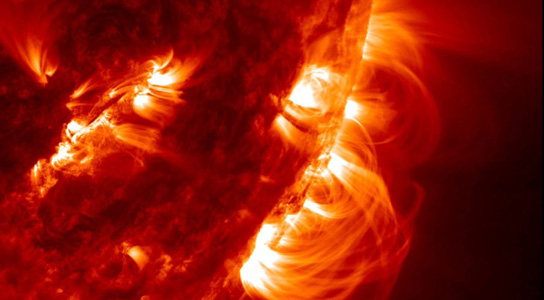Laboratory-Based Astrophysics Leads to Dedicated Discipline
November 21, 2012

A type of turbulence simulated in a lab experiment could help to explain why the Sun’s corona is so hot. Photo by SDO/NASA
The gigantic orange magnets at MIT were originally built decades ago to confine hydrogen nuclei in the search for nuclear fusion. However, since 1998 plasma physicist Jan Egedal has been using them to simulate magnetic fields in the thin wind of charged particles emanating from Sol. Egedal hopes to figure out how the solar wind can transfer energy.
These kinds of laboratory astrophysical experiments, in which efforts were made to mimic the behavior of space-borne plasmas and other phenomena, have had to rely on the apparatus of energy research or fundamental physics. Now, astrophysicists are trying to make the field a discipline in its own right, with its dedicated funding and equipment.
In June, the American Astronomical Society (AAS) in Washington DC created its first new discipline in 30 years, dedicated to laboratory-based astrophysics. At the American Physical Society’s plasma-physics meeting last month in Providence, Rhode Island, there were an unprecedented number of lab-astrophysics sessions. Even some NASA scientists are saying that the agency should devote some funding from every space mission to lab astrophysics.
Egedal is exploring questions posed by two solar wind missions, the ESA’s Cluster and NASA’s Wind. The work is attractive in times of tight budgets because the cost of most experiments tends to be hundreds of thousands of dollars instead of the hundreds of millions needed for space missions.
Last month, the first lab measurement of astrophysical turbulence in which two magnetic waves collide to generate a third one, a phenomenon that has been used to explain why Sol’s corona is thousands of times hotter than its surface and how massive amounts of energy move between galaxies, was described. Using the Large Plasma Device, a 21-meter-long plasma generator at the University of California, Los Angeles, two Alfvén waves were generated and collided. The daughter wave was mapped and this confirmed the celestial mechanism. This experiment cost less than $100,000 to perform.
Dedicated funding for lab astrophysics would be good news for Egedal, who is beginning to outgrow his current apparatus and wanting to build a new one.
No comments:
Post a Comment